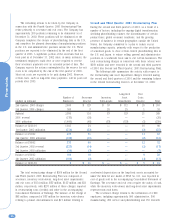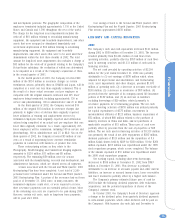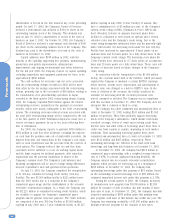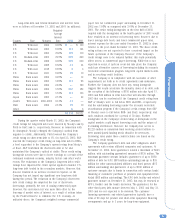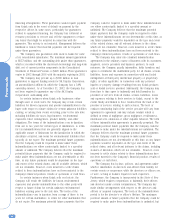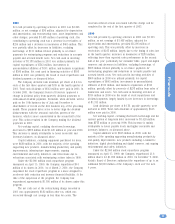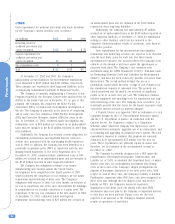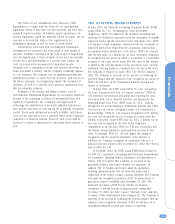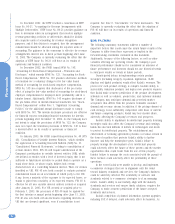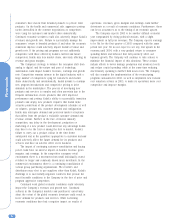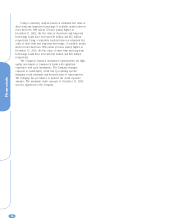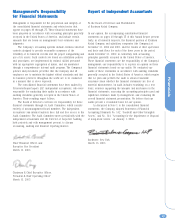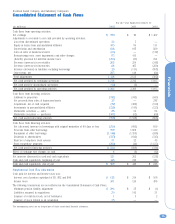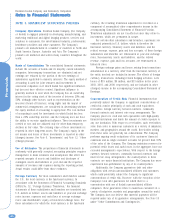Kodak 2002 Annual Report Download - page 34
Download and view the complete annual report
Please find page 34 of the 2002 Kodak annual report below. You can navigate through the pages in the report by either clicking on the pages listed below, or by using the keyword search tool below to find specific information within the annual report.
Financials
34
In November 2002, the EITF reached a consensus on EITF
Issue No. 00-21, “Accounting for Revenue Arrangements with
Multiple Deliverables.” EITF Issue No. 00-21 provides guidance on
how to determine when an arrangement that involves multiple
revenue-generating activities or deliverables should be divided
into separate units of accounting for revenue recognition
purposes, and if this division is required, how the arrangement
consideration should be allocated among the separate units of
accounting. The guidance in the consensus is effective for revenue
arrangements entered into in fiscal periods beginning after June
15, 2003. The Company is currently evaluating the effect that the
adoption of EITF Issue No. 00-21 will have on its results of
operations and financial condition.
In December 2002, the FASB issued SFAS No. 148,
“Accounting for Stock-Based Compensation – Transition and
Disclosure,” which amends SFAS No. 123, “Accounting for Stock-
Based Compensation.” SFAS No. 148 provides alternative methods
of transition for a voluntary change to the fair value based
method of accounting for stock-based employee compensation.
SFAS No. 148 also requires that disclosures of the pro forma
effect of using the fair value method of accounting for stock-based
employee compensation be displayed more prominently and in a
tabular format. Additionally, SFAS No. 148 requires disclosure of
the pro forma effect in interim financial statements. See “Stock-
Based Compensation” within Note 1, “Significant Accounting
Policies” for the additional annual disclosures made to comply
with SFAS No. 148. The interim disclosure provisions are effective
for financial reports containing financial statements for interim
periods beginning after December 15, 2002. As the Company does
not intend to adopt the provisions of SFAS No. 123, the Company
does not expect the transition provisions of SFAS No. 148 to have
a material effect on its results of operations or financial
condition.
In January 2003, the FASB issued Interpretation No. 46 (FIN
46), “Consolidation of Variable Interest Entities,” which clarifies
the application of Accounting Research Bulletin (ARB) No. 51,
“Consolidated Financial Statements,” relating to consolidation of
certain entities. First, FIN 46 will require identification of the
Company’s participation in variable interest entities (VIE), which
are defined as entities with a level of invested equity that is not
sufficient to fund future activities to permit them to operate on a
stand alone basis, or whose equity holders lack certain
characteristics of a controlling financial interest. Then, for entities
identified as VIE, FIN 46 sets forth a model to evaluate potential
consolidation based on an assessment of which party to the VIE,
if any, bears a majority of the exposure to its expected losses, or
stands to gain from a majority of its expected returns. FIN 46 is
effective for all new variable interest entities created or acquired
after January 31, 2003. For VIE created or acquired prior to
February 1, 2003, the provisions of FIN 46 must be applied for
the first interim or annual period beginning after June 15, 2003.
FIN 46 also sets forth certain disclosures regarding interests in
VIE that are deemed significant, even if consolidation is not
required. See Note 6, “Investments,” for these disclosures. The
Company is currently evaluating the effect that the adoption of
FIN 46 will have on its results of operations and financial
condition.
RISK FACTORS
The following cautionary statements address a number of
important factors that could cause the actual future results of the
Company to differ from those expressed or implied in the
forward-looking statements contained in this document.
Additionally, because of the following factors, as well as other
variables affecting our operating results, the Company’s past
financial performance should not be considered an indicator of
future performance and investors should not use historical trends
to anticipate results or trends in future periods.
Unanticipated delays in implementing certain product
strategies (including category expansion, digitization, OLED
displays and digital products) would affect Kodak’s revenues. The
process for each product strategy is complex. Kodak’s ability to
successfully transition products and deploy new products requires
that Kodak make accurate predictions of the product development
schedule as well as volumes, product mix, and customer demand.
The Company may anticipate demand and perceived market
acceptance that differs from the products realizable customer
demand and revenue stream. In addition, if the pricing element of
each strategy is not sufficiently competitive with those of current
and future competing products, Kodak may lose market share,
adversely affecting the Company’s revenues and prospects.
Kodak’s ability to implement its intellectual property licensing
strategies could also affect the Company’s revenue and earnings.
Kodak has invested millions of dollars in technologies and needs
to protect its intellectual property. The establishment and
enforcement of licensing agreements provides a revenue stream in
the form of royalties that protects Kodak’s ability to further
innovate and help the marketplace grow. Kodak’s failure to
properly manage the development of its intellectual property
could adversely affect the future of these patents and the market
opportunities that could result from the use of this property.
Kodak’s failure to manage the costs associated with the pursuit of
these licenses could adversely affect the profitability of these
operations.
In the event Kodak were unable to develop and implement
e-commerce strategies that are in alignment with the trend
toward industry standards and services, the Company’s business
could be adversely affected. The availability of software and
standards related to e-commerce strategies is of an emerging
nature. Kodak’s ability to successfully align with the industry
standards and services and ensure timely solutions, requires the
Company to make accurate predictions of the future accepted
standards and services.
Kodak’s completion of planned information systems upgrades,
including SAP, if delayed, could adversely affect its business. As


